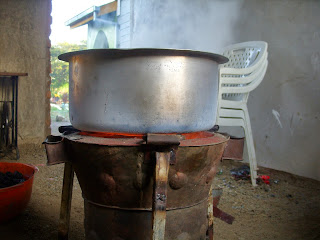
Tea with Mandazi Photo by maureendidde / CC BY 
Serving Tea at a Community Gathering Photo by advocacy_project / CC BY 
Chai Made in Big Bucket Photo by inthehandofdante / CC BY |
In Swahili (and Hindi), Chai means tea. While many
people like to enjoy tea with snacks, Kenyan tea often goes well with a snack
called Mandazi or mandaazi,
a semi-sweet fried bread originated from Eastern Africa. [1]
FLAVOR
Compare to Indian
Chai, Kenyan Chai usually adds a lot more sugar, which makes it sweeter. [2] The recipe can be as simple as mixture of tea, milk, and sugar, omitting Masala mix. (Asian spice mixture) [3]
CULTURE
In Kenya, tea is enjoyed anytime. It is served at breakfast, morning break, after lunch, afternoon tea, after dinner. According to Sadia's Tea Party, "Teatime [in Kenya] is a custom borrowed from the British
colonial past and tea making style
originated in India with some African influences." [4]
Like many tea cultures around the world, Chai is served as a part of showing hospitality to guests and
visitors.
HISTORY
Tea was firstly introduced to Kenya by an European man named G.W. L. Caine in 1903.
The
first tea grown for cultivation and consumption started in 1918 on a plantation
called Kiambethu Farm. Over the years, tea growing region has expanded to the Great Rift Valley and Nairobi. [5] Today, Kenya exports more tea than India, Sri Lanka, and China. [6]
PREPARATION
In Kenya, Chai is commonly
prepared in a large pot. Depending on the region, tribe, or social class in
Kenya, Chai is made differently. At some regions, they use goat milk rather than cow milk. [7]
|
Tuesday, May 6, 2014
KENYAN CHAI
Subscribe to:
Post Comments (Atom)







No comments:
Post a Comment